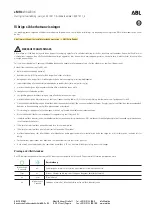
#
Press the wheel firmly against the
wheel hub when screwing on the first
wheel bolt.
#
Tighten the wheel bolts evenly in a diagonal
pattern in the order indicated until they are
finger-tight.
#
Unscrew the alignment bolt.
#
Tighten the last wheel bolt until it is finger-
tight.
#
Lower the vehicle (
→
page 463).
Lowering the vehicle after a wheel change
Requirements:
R
The new wheel has been installed
(
→
page 462).
#
Place the ratchet onto the hexagon nut of the
jack so that the letters "AB" are visible.
#
To lower the vehicle: turn the ratchet of the
jack counter-clockwise.
#
Tighten the wheel bolts evenly in a diagonal
pattern in the order indicated (
1
to
5
).
Specified tightening torque: 111 lb-ft
(150 Nm).
&
WARNING Risk of injury through incor‐
rect tightening torque
The wheels could come loose if the wheel
bolts or wheel nuts are not tightened to the
prescribed tightening torque.
#
Make sure the wheel bolts or wheel
nuts are tightened to the prescribed
tightening torque.
#
If you are not sure, do not move the
vehicle. Consult a qualified specialist
workshop and have the tightening tor‐
que checked immediately.
#
Check the tire pressure of the newly moun‐
ted wheel and adjust accordingly.
#
Vehicles with a tire pressure monitoring
system: Restart the tire pressure monitoring
system (
→
page 441).
Make sure to observe the following further rela‐
ted subject:
R
Notes on tire pressure (
→
page 435)
Wheels and tires 463
















































